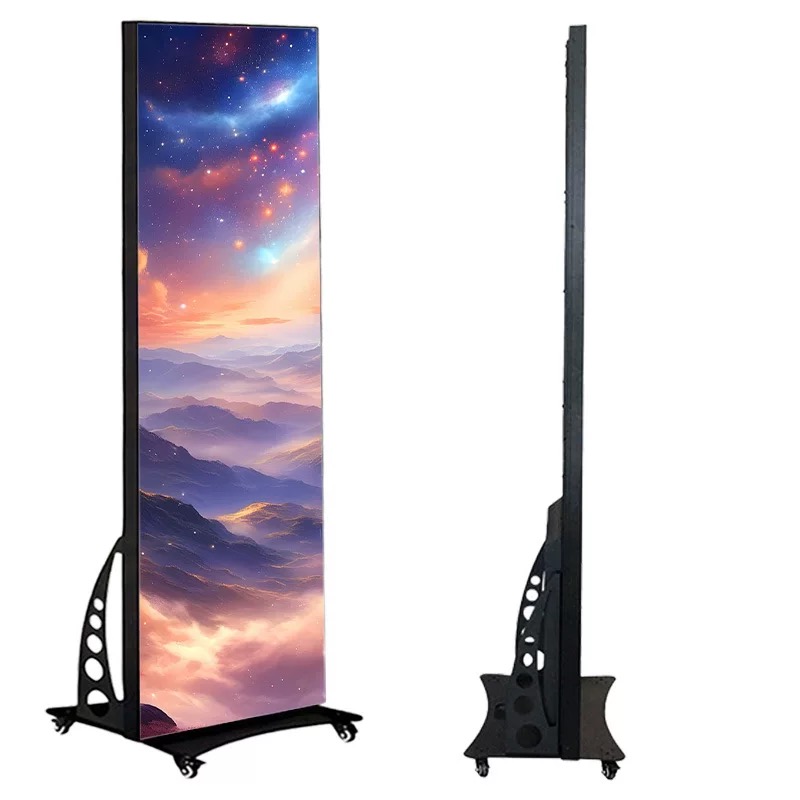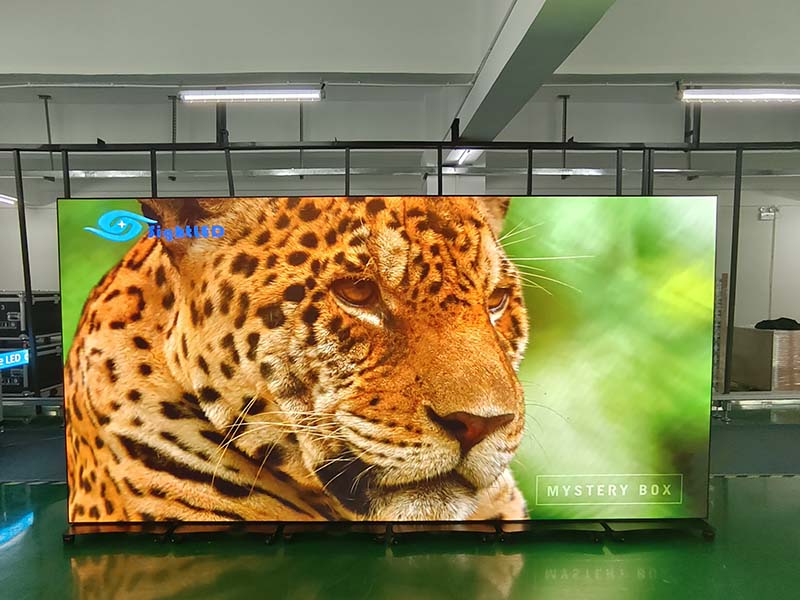LED screens and video walls are the predominant large-screen displays in today’s market, finding extensive applications in retail advertising, exhibitions, trade shows, and conferences. With rapid advancements in display technology, LED screens have emerged as a formidable contender, continuously improving across various parameters. Consequently, businesses are increasingly pondering whether LED screens outshine video walls as the superior option.
In this article, we will look at the differences between LED screens and video walls. We will also explain which display will be a better choice when it comes to different scenarios or applications.
Table of Contents
Toggle1. What is a LED Video Wall?
A video wall isn’t a standalone product; rather, it’s a customized arrangement of multiple smaller LCD screens or monitors that are tiled together to create a single, larger display. For instance, if a 55-inch LCD screen isn’t sufficient for your needs, you can combine four of these screens to effectively create a 110-inch display.

Pixel Pitch 0.56(H) x 0.56(V) mm
This setup requires more than just the individual displays; it also necessitates a video wall processor. This processor is essential for controlling the displayed content and its presentation. Whether it’s showcasing different content on separate displays or stretching a single piece of content across all screens, the video wall processor enables users to manage the displayed content in real-time.
2. What is an LED Display Screen?
An LED screen is a direct-view display constructed using multiple LED modules or panels. Unlike video walls, which feature a covered front glass on each display, LED screens consist of numerous light-emitting diodes (LEDs) on each panel. These LEDs emit light when an electric current passes through them.

SightLED indoor fixed installation LED screen can be attached on the wall without space behind it, the maintenance can be completely done from front.
In terms of appearance, the seams between LED modules are typically invisible, creating a seamless viewing experience. In contrast, video walls often have noticeable bezels between individual displays.
What is the different from LED and LCD Display Technology
LED (Light Emitting Diode) and LCD (Liquid Crystal Display) are two distinct display technologies with different underlying principles:
LED Display Technology:
- Light Source: LED displays use light-emitting diodes (LEDs) as the light source. Each pixel on the screen is made up of individual LEDs, which emit light directly. LED displays can be either full-color (RGB) or monochrome (single-color), depending on the type of LEDs used.
- Brightness and Contrast: LED displays typically offer higher brightness levels and better contrast ratios compared to LCD displays. This makes them well-suited for outdoor use and environments with high ambient light.
- Energy Efficiency: LED displays are known for their energy efficiency. They consume less power compared to LCD displays, making them more cost-effective to operate, especially for large screens.
- Durability: LED displays are more durable and resistant to damage from shock, vibration, and environmental factors. They have a longer lifespan compared to LCD displays, making them suitable for long-term installations.
LCD Display Technology:
- Light Modulation: LCD displays use liquid crystals to modulate the intensity of light emitted by a backlight. The liquid crystals act as shutters, allowing or blocking light to pass through individual pixels.
- Backlight: LCD displays require a separate backlight source to illuminate the screen. This backlight can be either fluorescent (CCFL) or LED-based, depending on the type of LCD display.
- Color Reproduction: LCD displays rely on color filters to produce different colors on the screen. They typically offer good color accuracy and uniformity but may have limitations in achieving deep blacks and high contrast ratios compared to LED displays.
- Viewing Angles: LCD displays may exhibit changes in color and contrast when viewed from different angles, especially in older or lower-quality models. However, newer LCD technologies, such as IPS (In-Plane Switching), offer improved viewing angles and color consistency.

In summary, LED displays utilize individual light-emitting diodes for direct light emission, providing advantages in brightness, contrast, energy efficiency, and durability. On the other hand, LCD displays modulate light using liquid crystals and require a separate backlight source, offering advantages in color reproduction and viewing angles. The choice between LED and LCD display technology depends on factors such as application requirements, budget, and environmental conditions.
What is the different from LED screen and LCD video wall Size & Shape
LED screens and LCD video walls are two common types of display technologies used for large-scale visuals, such as in advertising, entertainment venues, or corporate settings. Here are the key differences between them in terms of size and shape:
Size:
- LED Screen: LED screens are highly flexible in terms of size. They can be customized to fit various dimensions, ranging from small displays for indoor use to massive outdoor billboards. LED screens are often used for large-scale applications where a seamless display over a considerable area is required.

- LCD Video Wall: LCD video walls typically come in predefined panel sizes, such as 46 inches, 55 inches, or 65 inches. The size of the video wall is determined by the number of panels used and their arrangement. While LCD panels can be combined to create very large displays, they may not be as flexible in terms of size customization as LED screens.
Shape:
- LED Screen: LED screens can be constructed in various shapes, including flat screens, curved screens, cylindrical screens, and even custom shapes. This flexibility allows LED screens to be adapted to different architectural designs or creative requirements.

- LCD Video Wall: LCD video walls are typically rectangular in shape due to the shape of the individual LCD panels. While some degree of flexibility exists in arranging these panels, such as creating video walls with curved or irregular outlines, the overall shape is often constrained by the shape of the panels themselves.

In summary, LED screens offer more flexibility in terms of size and shape customization compared to LCD video walls, which are typically constructed using standardized rectangular panels. LED screens are often preferred for outdoor and large-scale applications, while LCD video walls are commonly used for indoor displays in environments such as control rooms, retail spaces, and conference rooms.
What is the different from LED screen and LCD video wall Screen Resolution
LED screens and LCD video walls differ in terms of screen resolution, which refers to the number of pixels contained on the display surface. Here’s how they compare:
- LED Screen:
- LED screens typically offer a wide range of resolutions, ranging from standard definition (SD) to high definition (HD), full HD (FHD), 4K, and even 8K resolutions.
- The resolution of an LED screen depends on factors such as the size of the screen, the pixel pitch (distance between individual LEDs), and the quality of the LED modules used.
- LED screens are capable of achieving high resolutions suitable for applications requiring detailed images and graphics, such as advertising billboards, digital signage, and large-scale displays.
- LCD Video Wall:
- LCD video walls also come in various resolutions, but they are typically limited by the resolution of the individual LCD panels that make up the video wall.
- The resolution of an LCD video wall is determined by the resolution of each LCD panel multiplied by the number of panels used in the video wall configuration.
- Common resolutions for LCD panels include HD (720p), full HD (1080p), and Ultra HD (4K). Therefore, the resolution of an LCD video wall can vary depending on the number and arrangement of panels.
- LCD video walls are often used in applications where high-resolution images and videos are required but may not achieve the same pixel density as LED screens due to the seams between individual panels.

In summary, LED screens generally offer more flexibility in achieving higher resolutions compared to LCD video walls, which are limited by the resolution of the individual LCD panels. LED screens are often preferred for applications requiring high-resolution displays with seamless visuals, while LCD video walls are suitable for indoor environments where a large display area is needed but absolute resolution may be less critical.
Outdoor Application
Video wall is strictly for indoor application only.
LED screens can be used in both indoor and outdoor applications. An outdoor LED screen is normally built by using multiple IP-rated LED cabinets. These weatherproof LED cabinets provide extra protection to all electronic components within the LED panel. In terms of display brightness, an outdoor LED screen is brighter to ensure high screen readability during the daytime.
Lifespan
When it comes to lifespan, the answer is straightforward. The lifespan of a well-maintained LED screen is two times more than the lifespan of an LCD display or a video wall. An LED screen can generally last for 100,000 hours while a video wall can only last for 50,000 hours.
However, you must also pay attention to other factors such as heat dissipation, quality of power supply, and content usage to ensure a healthy lifespan of the LED screen.
How much do the LED display and LCD video wall
The cost of LED displays and LCD video walls can vary significantly depending on several factors, including the size, resolution, quality, brand, and specific requirements of the project. However, I can provide a general idea of the price range for each type of display:
- LED Displays:
- LED displays are typically more expensive than LCD video walls due to factors such as the cost of LED modules, control systems, and installation.
- The price of LED displays can range from a few hundred dollars per square meter for lower-quality indoor displays to several thousand dollars per square meter for high-resolution outdoor displays or custom configurations.
- Large LED displays used for outdoor advertising or stadium displays can cost millions of dollars, especially for high-resolution and high-brightness models.
- LCD Video Walls:
- LCD video walls are generally more affordable than LED displays, especially for indoor applications.
- The cost of LCD video walls depends on factors such as the size and resolution of the individual panels, the number of panels required to create the video wall, and any additional features such as touch capability or bezel width.
- Entry-level LCD video walls with lower resolution and standard-sized panels can start from a few thousand dollars for a small configuration. High-resolution, large-scale video walls with thin bezels and advanced features can cost tens of thousands to hundreds of thousands of dollars.
Which to Choose: LED Screen or Video Wall?
Choosing between an LED screen and a video wall depends on various factors such as your specific requirements, budget, intended use, and environmental conditions. Here are some considerations to help you make an informed decision:
- Budget:
- If you have a limited budget, a video wall may be a more cost-effective option, especially for indoor applications where high brightness and weather resistance are not essential.
- LED screens generally have a higher upfront cost but may offer better long-term value due to their durability, energy efficiency, and lower maintenance requirements.
- Size and Resolution:
- LED screens are highly customizable and can be made in virtually any size and resolution, making them suitable for large-scale displays with high visual impact.
- Video walls are composed of individual panels with fixed sizes and resolutions, limiting their scalability and resolution flexibility compared to LED screens.
- Brightness and Visibility:
- LED screens typically offer higher brightness levels than LCD video walls, making them suitable for outdoor applications or environments with high ambient light.
- Video walls may struggle in brightly lit environments or outdoor settings due to lower brightness levels and potential glare.
- Seamlessness and Viewing Angle:
- LED screens provide a seamless viewing experience since they are constructed using single panels without visible bezels.
- Video walls consist of multiple panels with narrow bezels, which can create visible seams between the panels, affecting the viewing experience, especially from close distances.
- Content Flexibility:
- LED screens often offer better color reproduction, contrast ratio, and refresh rates compared to LCD video walls, making them ideal for displaying high-quality video content and dynamic visuals.
- Video walls may be sufficient for displaying static or less demanding content, such as informational displays or advertising with predominantly text and images.
- Installation and Maintenance:
- LED screens may require more complex installation and maintenance procedures, especially for large-scale installations or outdoor use.
- Video walls are generally easier to install and maintain, with individual panels being replaceable in case of damage or malfunction.
Ultimately, the choice between an LED screen and a video wall depends on your specific needs, preferences, and budget constraints. It’s essential to thoroughly evaluate your requirements and consider factors such as display size, resolution, brightness, content type, and installation logistics before making a decision. Additionally, consulting with display technology experts or vendors can provide valuable insights and assistance in choosing the right solution for your application.






